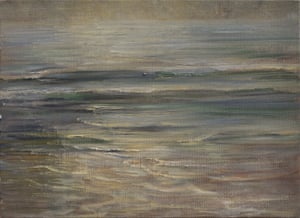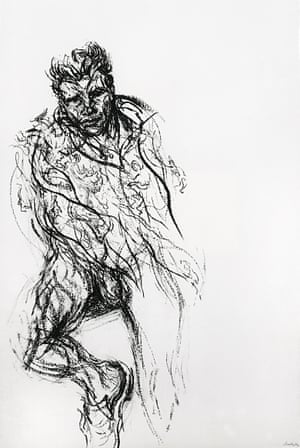Celia Paul: Desdemona for Hilton by Celia; Maggi Hambling: Touch – review
Victoria Miro Mayfair; British Museum, LondonPensive and radiating silence, Paul’s self-portraits are also alive with movement. Meanwhile, the gregarious, quickfire art of Hambling has its own surprises
The painter sits erect for her self-portrait as a solitary soul. Her long, narrow figure, slender of neck, head lifted, appears motionless and secret as a heron. Soft grey light flows around her, tinged with the pale gold and lemon that find their way into her flowing smock. It is an image of extreme gentleness, and yet the sheer tenacity of the likeness is what strikes – emerging out of the haze in bright fractions, bit by bit. The painting radiates silence.
There are several new self-portraits in this show and they all look like late works, the fruit of many seasons. Yet Celia Paul is only in her 50s. Born in India in 1959, educated at the Slade and internationally admired for her elegiac depictions of the people she loves (Paul never paints commissions), she has increasingly turned to face herself. The aura changes but not the pose – straight-backed, facing forwards, hands gathered in her lap, the long smock resembling a nun’s habit, the delicate face dense with thought. She looks both ancient and ageless.
In one picture, her face receives the cold blue light of dusk and the first glow of streetlight, as it seems. Deep circles beneath her eyes are like plum-coloured wounds. In another, with a wintry palette of black and ultramarine, the brows almost meet above her sorrowful eyes, and one ear appears naked, vulnerable from behind the curtain of hair. Her throat always looks exposed. Should you be allowed to look so closely at this intensely reticent woman: the question is irresistibly raised, and then answered, by each self-portrait. The justification is the painting.
Two of these images, in fact, hang in the windows at Victoria Miro – as well they might, for Paul’s self-portraits have been gaining in fame and force of personality down the years. There is a particular strength in their pensive beauty that is justifiably associated with other reclusive female painters such as Gwen John and Agnes Martin; indeed Paul had even been shown in tandem with John.
Like John, Paul’s paintings are infinitely measured, and her circle of sitters tiny. This show includes only portraits of the painter and her sister Kate, transfigured in pearly light like an angel, her face very slightly turned towards that light, as if dreaming or lost in meditation. She too wears that smock that removes her from her own life, her own clothes. Paul shows her sitters as separated entirely from their daily roles – out of this world, singular in their quietude.
In the past she has painted all four of her sisters, seated together on a bench (just as Paul herself was once painted by her ex-lover Lucian Freud). But this show is even less populous, and absent from it is Paul’s most devoted sitter, her mother, who died last year. Instead there are many paintings of a new subject, the sea, “a fluid interlude”, as Paul puts it, one of them so outstandingly liquid and live it hardly seems possible she could have conjured it from scumbled oil paint.
Every characteristic appears separately depicted – light, colour, motion, fluidity – and yet reunited in a vision of green water. The canvas is bare and coarse as sackcloth, the brushwork amazingly minimal: a pinprick of yellow, a white arc, a fusion of ivory and green. There is so little to see – and yet so much.
Indeed you want a new language for the way Celia Paul is painting now. In the portraits, particles of black and yellow appear in frissons or surface vibrations. Or colour settles like flakes of ash. Paint may be smoothed like fur, gently urged across the canvas or touched as if with the subtlest of fingertips. One has the most intimate sense of her hands working across the substrate.
In one large seascape, thinned paint sends down a Spanish moss of drips that hang on thick waves of coral, white and blue. In a startling painting of Paul’s bedroom, the tympanum of the British Museum, visible through the window, is practically sculpted out of dense white impasto. This beautiful room is empty of everything except the bed and the glowing rays entering through the window, so that the scene resembles an annunciation minus angel and virgin. It celebrates this little kingdom of light where Paul has lived in solitude for more than 30 years.
It would be hard to think of another contemporary painter whose self-portraits are so steeped in meditation and yet so quick with live touch. This is most visible in a painting made earlier this year, hard-won and sad and yet so brilliantly created from what look like the residual wipe marks another painter might have left on palette or rag. There is a thrift in these strokes, as if Paul was working with leftovers, and yet still the image emerges with an almost Rembrandtian richness. This is characteristic of her recent work: voluptuous and yet profoundly modest, fundamentally withdrawn and yet resolutely turned to the world.
Across the road from Paul’s bedroom, Maggi Hambling is having a kind of graphic retrospective of her long career in the British Museum. It takes in her charcoal drawing of the comedian Max Wall, all caricatural hands, crafty fag and outsize shoes. It has ink and wash portraits of Stephen Fry dozing, George Melly singing and John Berger in intense dialogue. There is a quickfire profile of Norman Rosenthal made in monotype using fingers as well as paintbrush.
THE GUARDIAN






No comments:
Post a Comment